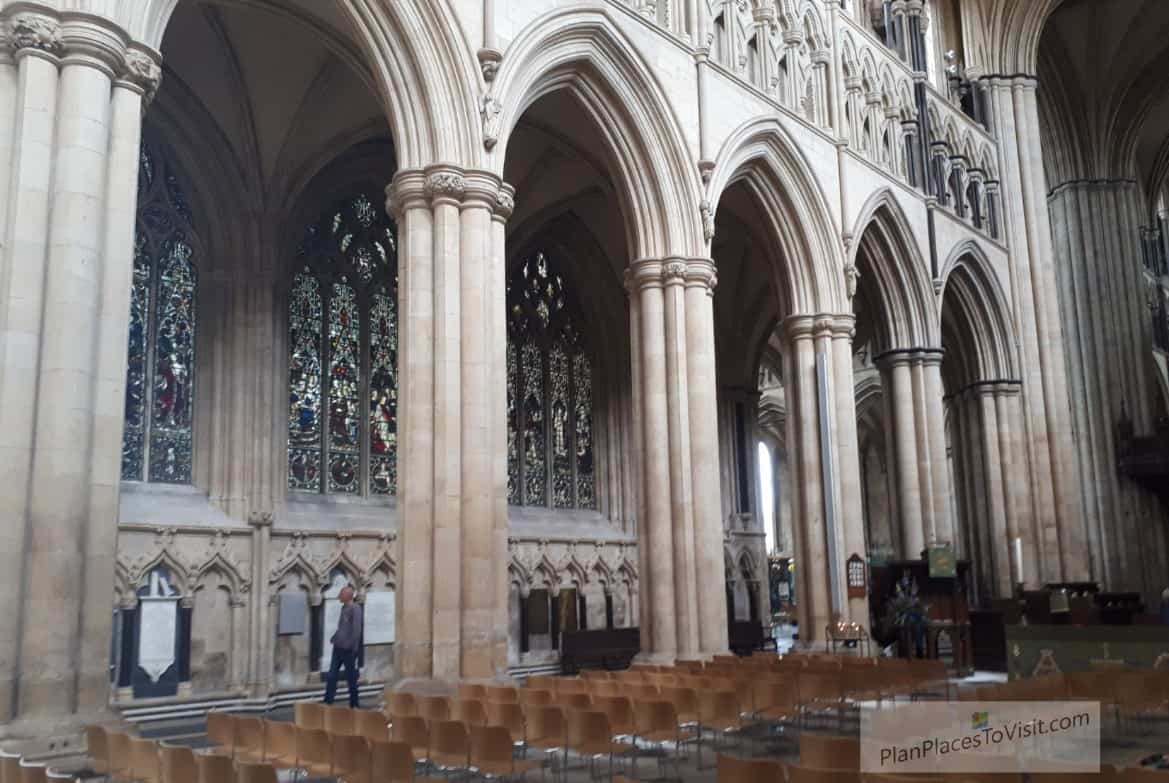Beverley Minster, free to enter, has awe-inspiring architecture with rose windows and similar Gothic arches to York Minster which has a £12.50 entry fee.
Contents
Why visit Beverley Minster?
Beverley Minster is beautifully located in Yorkshire and it is one of the largest parish churches in the UK. Beverley Minster is larger than one-third of all English cathedrals and regarded as a Gothic masterpiece – and Beverley Minster is free to enter! There are donation boxes that help with Beverley Minster’s expensive upkeep and are well worth your generous attention.
Beverley Minster is one of the finest Gothic churches in England. Beverley, steeped in English history also has beautiful market squares, quality restaurants and shopping, gorgeous Georgian townhouses, North Bar (Beverley’s 15th-century grand entrance) the beautiful St Mary’s church, a six-screen cinema, and a 300-year-old racecourse. Beverley was listed in a Sunday Times report on Best Places to Live in northern England, and also Beverley was named as the best place to live in the United Kingdom in an “Affordable Affluence” study by the Royal Bank of Scotland.
Beverley in England inspired the naming of the city of Beverly in Massachusetts which in turn inspired the naming of Beverly Hills in California.
Beverley Minster is 30 miles to the east by road from Selby Abby, also in Yorkshire. Selby Abby has President George Washington’s English ancestors depicted in its stained glass.
Why is Beverley called Beverley?
Beverley, the town in present-day Yorkshire, England, was founded around 700 AD by Bishop John of Beverley (he died 7 May 721). Around 300 years later he became Saint John of Beverley in 1037 and in his lifetime he was the Bishop of Hexham and then the Bishop of York. He had a reputation for healing the sick and he had many admirers. The town is named after him and Beverley Minster became a place of sanctuary and refuge. Throughout the medieval period, pilgrims travelled to Beverley in great numbers to visit his tomb. Old English King Athelstan who died in 939 granted the church and the town of Beverley sanctuary rights and to this day there is the Beverley Minster Sanctuary project that provides workshops for such crafts as stone carving, stained glass and needle felting.
Beverley Minster Church Explained
To get the best out of a wander around Beverley Minster it is helpful to know a little about it, and the names of the different parts first so you’ll appreciate the grandeur even more!
A distinctive feature of both the north and south transepts of Beverley Minster is the presence of rose windows and a White Rose of York.
What is a Transept in a Church?
A transept in a cross-shaped church such as Beverley Minster in Yorkshire, is either of the two parts forming the arms of the cross shape, projecting at right angles from the nave.
The great sixteenth-century east window of Beverley Minster still retains much of its original medieval stained glass, while the marble font dates back to the Norman era.
What is a Nave in a Church?
The nave is the central and principal part of a Christian church such as Beverley Minster in Yorkshire, starting from the entrance to the transepts. The nave is that part of a church set apart for the laity (the congregation) as distinct from the chancel which is reserved for those who run the church and that includes the choir and clergy. Dramatic effects, such as the marked verticality of the Gothic minsters and cathedrals such as Beverley Minster, are particularly awe-inspiring.
The separation of the two areas may be achieved by screens or parapets and these are called cancelli.
The name nave comes from the Latin navis, meaning a ship and it has been suggested that the word nave may have been originally chosen to designate the main body of the church because the ship was adopted as a symbol of the church.


When was Beverley Minster Built?
A church was originally founded on the site during the 700s and the present Beverley Minster was built in the period 1188-1490 using limestone throughout, mostly from Tadcaster, about 10 miles away – the stone used since the 14th century is Magnesian Limestone. Beverley Minster’s roof is nearly the size of 3 full football pitches and most of it is leaded, so the load bearing down on the masonry beneath is immense.

Beverley Minster and King Henry VIII and Queen Elizabeth I
After the havoc caused by Henry VIII’s dissolution of the monasteries, which began in 1536, The Act of Supremacy in 1534 confirmed the break from Rome. This declared Henry VIII to be the Supreme Head of the Church of England, and later his daughter, Queen Elizabeth I inherited a nation in religious flux on 17 November 1558.
Queen Elizabeth I, unlike her father Henry VIII, didn’t want such confrontation and she wanted to “Unite the people of this realm into a uniform order of religion.”
Queen Elizabeth I was one of the instigators of the Beverley Minster Old Fund, a charity established to make sure that there was always enough money for the repair, restoration and maintenance of Beverley Minster, one of England’s most loved buildings. Historians believe that Queen Elizabeth I has a crisis of conscience after he father’s devastating attacks on religious buildings, so she wanted to establish and restore some sort of harmony between the state and the church.
Beverley Minster Old Fund continues its work to this day, making it one of the longest-established charitable foundations in Britain, working away behind the scenes for nearly 500 years.
The main thing Beverley Minster lost because of Henry VIII was the Chapter House, as shown on the plan, but just about everything else remains.
Beverley Minster and the Queen.
In July 2022, as part of the Platinum Jubilee celebrations, 3 artworks were put on display at Beverley Minster depicting The Queen, Prince Philip and a royal corgi. 2022 also marks 20 years since the Queen last visited Beverley Minster in 2002, the Queen’s Golden Jubilee year.

Beverley Minster Stained Glass



The magnificent stained glass in Beverley Minster has been added to and changed over the centuries since 1170. The Great West Window was built between 1859 and 1864 by Hardman & Company of Birmingham and tells the early history of Christianity in Northumbria.
The latest addition to Beverley Minster’s glass is in the modern Retroquire adjacent to the East Window. It is part of an art installation, commissioned by the Friends of Beverley Minster by Helen Whittaker who made the glass for the windows designed by David Hockney in Westminster Abbey.
Beverley Minster Great East Window
The oldest stained glass in Beverley Minster is the Great East Window. The eastern end of the Minster was built in the 13th century. However, fashions changed so the original lancet windows were replaced by the large 1416 perpendicular, upright style window still there today.
The Great East Window contains a representation of King Athelstan and Saint John of Beverley.
Although the glass would have been contemporary with the window of 1416, the great storm of 1608 blew out and damaged the glass in this and other windows at Beverley Minster. The result today is a collection of glass from the 13th to 15th centuries that were pieced together in 1645, in the fourth year of the English Civil War.
The window has had several restorations and was completely removed in the 20th century during World War 2.
How Stained Glass is Made
Stained glass as found at Beverley Minster in Yorkshire is made of molten sand (silica) and ash from a wood fire (potash) and is coloured by adding metals such as copper, cobalt, iron and gold.
Pieces of glass are placed on a previously designed drawing and cut to size and strips of lead with grooves that hold the glass and different shapes are joined together by soldering the lead. Putty is also used to fill in small gaps to make the window weathertight.
Beverley Minster Font
The font at Beverley Minster dates from around 1170, after the Norman Conquest of 1066 and is a typical design of that period. Beverley Minster’s Norman Font survived the fire of 1188 that damaged the previous Norman church to such an extent that the decision was made to rebuild Beverley Minster rather than repair it and the building programme lasted 250 years.
Beverley Minster’s font was made from polished limestone known as Frosterley Marble and has a large number of fossils embedded in the stone and it is probably the earliest surviving example of a font made from this material.

Beverley Minster Font has been in continuous use for Christenings for over 850 years and in the 18th-century restoration of Beverley’s Minster, a wooden cover was designed by Hawksmoor and carved by William Thornton of York.

Beverley Minster Tours
Beverley Minster holds free tours lasting about 20 minutes on Friday and Saturday at 10:30 – 15:30 and Sunday 13:00 – 16:00. Booking is not required as they are on a first-come, first-served basis. On Sundays, there are also “about the organ” tours by the Director of Music at 13:30, 14:30 and 15:30, also lasting about 20 minutes on the same first come, first served basis.
There are also separate bookable and chargeable tours to both the ground floor and roof areas. On the Beverley Minster Roof Tour, you are escorted up a medieval 113-step spiral staircase to the rafters in the roof.
Beverley Minster Roof Tour times – Tuesday 11:00a.m, Wednesday 12 noon and Saturday 11:00a.m and 14:00
Beverley Minster Ground Floor Tour times – Wednesday 11 am and Saturday 11:00a.m
Beverley Minster Graffiti
There are generally inaccessible sections of Beverley Minster that connect the present day to our ancestors that have varied graffiti carved in the stone, scribbled on its beams and etched into the glass.
Beverley Minster – Sanctuary in the Churchyard
The archaeological dig of 1979 confirmed the traditional view that Beverley Minster was built on the site of a monastery founded by Bishop John of York. Inspired by the medieval legacy, Beverley Minster now has a wildflower meadow providing an attractive environment for those seeking sanctuary and a thriving haven for wildlife.
The Beverley Minster Secret Garden
Beverley Minster’s Secret Garden is an amazing place but has limited opening times during the year and is an oasis of green.
The garden is constantly changing, with new things to see and is a haven for wildlife, hidden behind houses and is unknown even to some neighbours.
Beverley Minster’s Secret Garden is signposted from Beverley Parish Centre. For those with accessibility issues, there are some uneven paths so care is needed for wheelchairs and pushchairs. Toilets are close by at the Minster.
Beverley Grammar School
The medieval Beverley Grammar school was located in the Beverley Minster churchyard and was rebuilt in 1606, so for many centuries Beverley Minster has been associated with Beverley Grammar School. However, that building was demolished in 1816 and rebuilt in Keldgate, Beverley.
Beverley Almshouses
Four Almshouses were built close to Beverley Minster and two are still used – Charles Warton’s (1688) and Anne Routh’s (1749). These Almshouses provided communal living for the elderly who lived rent-free and also received a weekly living allowance.
The Wartons of Beverley Parks were generous benefactors to Beverley Minster and the town of Beverley and there is a Warton memorial in Beverley Minster.

.

